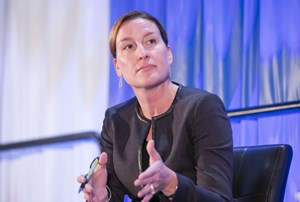OTC 2022: Enroute to transition, BP expects GOM hydrocarbons to remain vital
Among all of its oil and gas assets, major operator bp expects its properties in the U.S. Gulf of Mexico to remain a key part of its portfolio over the next decade, even as other upstream operations are discarded in the transition to alternative energy forms. That was the message delivered by Starlee Sykes, senior vice president for the Gulf of Mexico and Canada.
Speaking at the opening Keynote Speaker Series session that kicked off the entire OTC week on Monday, Sykes began her talk with comments on the progress of the Argos semisubmersible production platform that is now onsite in the deepwater Gulf of Mexico as part of the Mad Dog 2 project. The platform is expected to go onstream during second-quarter 2022. “Why do I start [my talk] with the story of Argos?”, said Sykes. “Because it comes at a time when hydrocarbons are in demand.” She noted the current market conditions of production shortfalls, high oil prices and the Ukraine-Russia conflict. “And we [GOM operations] are also the driver of BP’s strategy toward net zero.”
GOM development philosophy. Sykes said that bp has three technical focus points in the GOM, as relates to its development philosophy: 1) resilient hydrocarbons; 2) low-carbon energy; and 3) mobility and convenience. Indeed, she noted, “Our assets in the GOM are continuing to meet demand for resilient hydrocarbons. And our GOM business is producing some of the world’s highest-value hydrocarbons.”
She confirmed that by 2030, bp expects to reduce its hydrocarbon production by 40% from the 2019 baseline. “But this will not be even across all assets,” clarified Sykes, who said that a higher proportion of GOM output is likely to be retained. In addition to the output goal, bp is now aiming to reduce global emissions 50% by 2030.
GOM project update. In reviewing the status of bp’s various projects in the Gulf, Sykes said that “2021 was a pivotal year for us. We brought several projects online in a clean, sustained manner. She explained that Manuel, a subsea production system that ties into the Nakika platform and which started up last June, is a perfect example of bp’s current “high-value” projects.
Forecasting bp’s GOM activity through the remainder of 2022, Sykes said, “We are finding ways to boost and maximize our production in the Gulf. We are looking to expand Thunder Horse output this year to 200,000 bopd. Of course, in February, we started-up the Herschel Expansion project several months early. And Nikika [platform] this year will have the same output that it had 20 years ago.”
There is a consistent approach to bp’s work in the Gulf, as explained by Sykes. “We’re accomplishing our GOM strategy through leveraging our leadership in seismic work, developing infill projects, and focusing on system optimization.”
East Canada outlook. Another region that falls under Sykes’ responsibility is exploring and developing prospects offshore East Canada, principally off Newfoundland and Labrador. “Hand-in-hand with GOM work is our exploration off East Canada,” said Sykes. “We will conduct exploration northeast of St. John’s this year. And we will participate in two Equinor-operated wells in 2022. And we’re also planning a BP-operated exploration well offshore Newfoundland in 2023.”
Ukraine comments. Touching briefly on the Russia-Ukraine conflict in Eastern Europe, the senior V.P. noted that “bp has been shocked and saddened by the tragedy unfolding in Ukraine. I wholeheartedly support our decision to exit Rosneft, which occurred in February. Right now, oil prices are as high as they have been in a long time. Oil and gas remain critical to satisfying global energy demand.”
In an extended Q&A session, Sykes was asked by one attendee what technologies bp is employing, which help to allow low-carbon operations. She said a short list includes “accurate measurement, rotating equipment maintenance, cutting down flaring, and logistics.” She added that the company is also evaluating carbon capture and storage.



